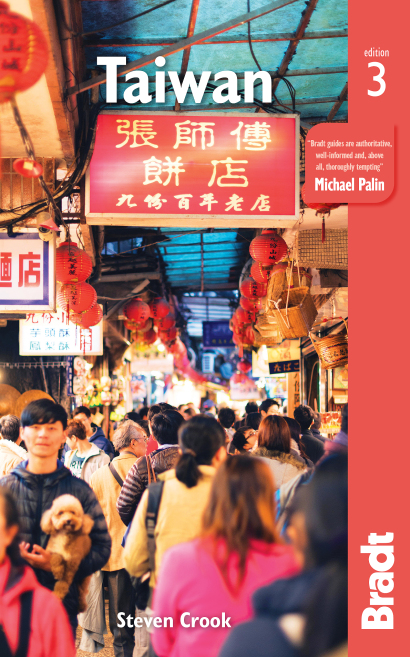If you’re familiar with China, it’s the differences between Taiwan and the mainland that’ll strike you, not the similarities.
Steven Crook, author of Taiwan: the Bradt Guide
Long famed for its economic triumphs, Taiwan’s abundant natural attractions have tended to fly under the radar. Yet this diminutive country more than lives up to its older name of Ilha Formosa, or ‘beautiful island’.
Its lofty mountains, marble-walled hot springs, lunar badlands and butterfly-thronged forests all appear to have come straight from a Chinese scroll painting. And then there’s the human drama, from the fashionable denizens of pulsating Taipei to the indigenous tribes who keep ancient traditions alive and those performing poignant rituals at exquisite folk shrines up and down the land.
The sheer density of sights in an island half the size of Tasmania makes Taiwan an unusually satisfying place to explore. Where else could you twitch rare waterbird species before breakfast, appreciate the grandeur of 17th-century Dutch-built forts in the run up to lunch, and still have time to drive through fruit orchards and monkey-infested foothills before pitching your tent – or settling into a luxurious homestay – a mile-and-a-half above sea level?
Nowhere else, in our experience, combines shocking yet safe urban colour with so much unspoiled nature, convenient transport, inexpensive and delicious food, and fantastically friendly, helpful people.
For more information, check out our guide to Taiwan
Food and drink in Taiwan
Food
Taiwanese eat a lot and eat often, so it isn’t surprising that around one in six is overweight. Many young women, however, are stick-thin. As in other east Asian countries, rice and noodles are staples. Sweet potatoes, taros and yams are secondary sources of carbohydrates.
As you’d expect on an island, seafood is common; much of the fish, however, is farmed rather than caught in the ocean. There’s a good selection of vegetables, especially cabbage, carrots, turnips and cucumbers. Vegetables are often fried with crushed garlic rather than boiled or steamed. Sweetcorn and various beans are common.
Pork is the most frequently eaten meat and those following a kosher or halal diet should assume that meat sauces are pork-based unless stated otherwise. Chicken and mutton are also popular. Most of the beef eaten in Taiwan is imported, and part of the population – perhaps one in ten – never eats beef.
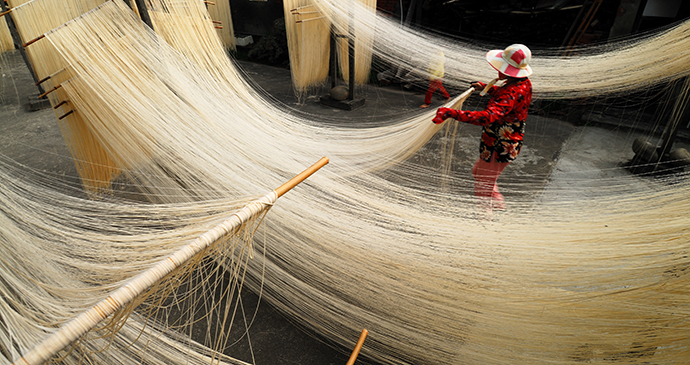
This prohibition dates from pre-industrial times when cattle and water buffalo were protected because they were needed for ploughing and manure. Goose and duck are easy to find. You may also have chances to try turtle, pigeon, frog, snake or snails – but not dog meat, the sale of which has been illegal since 2003.
Taiwanese cuisine
No longer regarded as a subset of or inferior to China’s culinary traditions, Taiwanese cooking emphasises neither spiciness nor sourness. Dishes are usually steamed, stewed or stir-fried. Taiwanese make the most of local seafood, and of the fresh ingredients that are available year-round.
Featured story
Five reasons to visit Taiwan
From ornate temples to tranquil islands, Taiwan boasts both cultural and natural treasures.
Rice was once thought to be very important indeed, but consumption has fallen dramatically in the past few decades as wheat-based alternatives became widely available. Even so, few Taiwanese go 48 hours without eating a bowl or two of steamed polished white rice (bái fàn 白飯).
Noodles (miàn 麵) are common; they’re usually served ‘dry’ with gravy (gān miàn 乾麵) or with chunks of meat in a soup. Taiwanese cuisine also has a vast range of broths and consommés that differ from European soups in that the liquid is often clear and somewhat oily, and the ingredients (which may include large pieces of bone) aren’t finely chopped.
Indigenous cuisines
Visitors should seize any chance they have to try indigenous foods. They’re available nowhere else in the world and, in the opinion of many people, indigenous cooking tastes very good indeed.
Indigenous feasts often include roasted or barbecued meat (some of it obtained by hunting), small fish and shrimp taken from mountain streams, and vegetables quite different from those seen in the lowlands. Until a few decades ago, millet was a staple food in many indigenous communities.
To some extent it’s been replaced by rice, but at festival time millet-based dishes are prominent. It’s during such events that you’ll see the most authentic indigenous foods, including items not offered in restaurants. Among the Bunun tribe, raw pickled flying-squirrel intestines are considered a special delicacy, as is what’s called ‘stinky meat’ – game that’s begun to rot after being left in the trap a little too long. It’s barbecued, fried with garlic and ginger, then served with a spicy sauce.
For indigenous families living in remote mountain communities, hunting and gathering remain important ways of obtaining food.
Drink
In addition to the usual fizzy soft drinks and supermarket fruit juices, Taiwan has an excellent selection of fresh fruit and vegetable juices, plus milkshakes made with local fruit like papaya, pineapple and mango. Cold tea is drunk in huge quantities; a Taiwanese invention variously known as ‘bubble milk tea’ or ‘pearl milk tea’ (cold black tea mixed with milk and tapioca balls) has caught on overseas.
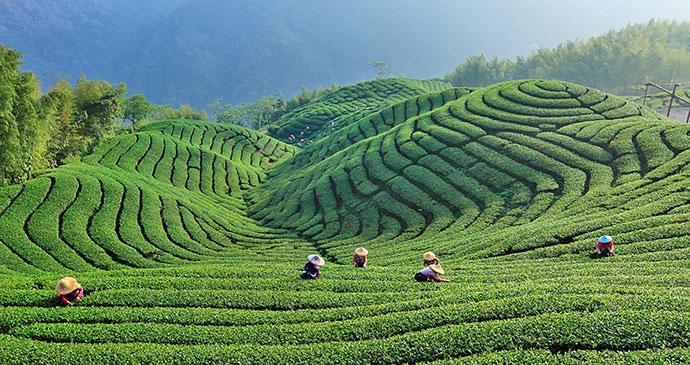
Taiwan Beer, a lager best drunk cold, is the most popular alcoholic tipple with more than 60% of the beer market. Popular imported brands include Heineken and Kirin (a Japanese brew). In many restaurants you’ll see refrigerators full of beer and other cold drinks.
Just help yourself; the staff will add the cost to your bill. Red wine is far more popular than white wine and there are several local wineries. The best-known spirit is kaoliang – the Chinese name means ‘sorghum’, which is its main ingredient – and it’s made in Kinmen County and the Matsu Islands.
Health and safety in Taiwan
Health
Taiwan is a healthy place but visitors should take some precautions, including taking out adequate insurance before leaving home.
Inoculations
No vaccinations are required except yellow fever, and then only if you’re coming from a yellow-fever endemic area such as sub-Saharan Africa or South America, as there is no risk of disease in Taiwan. It is wise to be up to date with standard vaccinations including diphtheria, tetanus and polio given in the UK as one vaccine (Revaxis), and also measles, mumps and rubella. Vaccination against hepatitis A, and possibly hepatitis B, rabies and Japanese encephalitis are advisable depending on your length of stay. Taiwan has a high prevalence of hepatitis B so vaccination would be recommended for those working in medical settings and with children, as well as for those playing contact sports. The course comprises three vaccines given over a minimum of 21 days for those aged 16 and over; younger travellers require a minimum of eight weeks to be vaccinated effectively. The Japanese encephalitis vaccine (Ixiaro) is recommended for those staying in rural parts of the country, and consists of two doses ideally given one month apart, so ensure that you have enough time if you need it. Taiwan also has one of the highest incidences of hepatitis A in the world; one dose of the vaccine will provide cover for one year and can then be boosted to extend protection to around 25 years.
Safety
Taiwan is one of the world’s safest countries for tourists. Street crime isn’t a big issue, even late at night, and there’s little danger of being harassed by a drunk. That said, homeowners do take precautions against burglary – hence the metal bars over windows and balconies – and pickpockets work festival and night-market crowds.
Traffic is the major threat to your well-being. Be very careful when crossing roads. Don’t just look both ways, look in every direction as two wheelers often use the pavements or pedestrian crossings. There are two reasons why self-driving visitors should think twice before stopping at what appears to be the aftermath of a traffic accident: lawsuits and robberies. If you take an individual to hospital, you may later be held responsible for their death or injuries. Also, criminals have been known to stage fake-crash scenes on quiet country roads and beg passing drivers to stop. Good Samaritans have, for their trouble, been robbed and had their vehicles stolen.
Up-to-date advice from the Foreign Office can be found at www.gov.uk/foreign-travel-advice/taiwan.
Natural hazards
Taiwan suffers both earthquakes and typhoons but these shouldn’t stop you visiting. If you cycle or hike in the lowlands or the foothills, keep an eye out for aggressive dogs. If you’re confronted by one, pick up a stone or some gravel. In the countryside you should also be wary of but not paranoid about snakes (six poisonous species are fairly common) and hornets. The latter have been known to kill people.
Police
Taiwan’s police force doesn’t have a stellar reputation for efficiency or enforcement but as a foreign visitor you can expect courtesy and assistance. All police stations are marked in English as well as Chinese. Few officers speak good English but if you go into a larger station you’ve a much better chance of finding someone who can communicate.
Female travellers
Apart from being careful when taking taxis by themselves late at night, female tourists needn’t take any exceptional precautions. Western women rate Taiwan highly in terms of hassle-free travelling.
LGBTQ+ travellers
Attitudes to homosexuality have changed dramatically in the past two decades. There are now gay venues in the major cities and an annual gaypride parade in Taipei. However, many gay men still face immense pressure from traditional parents to marry and continue the family line; the consequences of this form the basis of Ang Lee’s 1993 film The Wedding Banquet. Some gay women come up against the traditional notion that an unmarried adult woman is somehow incomplete. However, the number of women (straight or gay) remaining unmarried well into their thirties has soared in recent years.
There’s a chance Taiwan will become the first country in Asia to allow same-sex marriage. In May 2017, the highest court ruled that same-sex couples have a right to marry under the constitution and that the parliament has two years to amend the marriage laws to align with this. If this is not done, same-sex couples will be able to have their unions registered as marriages and be treated as such by law. Marriage equality remains an uphill battle, however. At the time of writing, a bill to legalise same-sex marriage has been drafted but not passed, and groups opposed to marriage equality won two non-binding referendums in November 2018.
One of the few prominent individuals to have come out is Lin Hwai-min, founder of Cloud Gate Dance Theatre. In 2016, the new administration appointed Audrey Tang (b1981), a transgender woman who describes herself as an anarchist, to a minister-without-portfolio position with responsibility for digital communications and the sharing economy.
Local gay organisations include the Taiwan Tongzhi Hotline Association. English speakers will find www.travelgay.com useful.
Travelling with children
Taiwan is a safe and welcoming destination for travellers with children. In restaurants, temples and shops, Taiwanese people show great tolerance towards kids who are noisy or fidgety. Children with Western features attract plenty of positive attention. Parents must, of course, take steps to protect their children against Taiwan’s traffic, strong sunshine and mosquitoes, but in terms of food, cleanliness and general public health, Taiwan isn’t a dangerous place.
If you plan to use a pushchair for any distance, be prepared for an obstacle course. In many places in urban Taiwan the pavement isn’t flat or doesn’t exist at all. Also, it isn’t unusual for shopkeepers to pile so much merchandise on the pavement that pedestrians are forced to detour into the road. Parents with babies will find there are few nappy-changing stations except those at department stores, large supermarkets, metro stations and some train stations.
Anyone with a young child knows it’s essential to bring an extra set of clothes, including shoes, when going away from your base for more than a few hours. Taiwan’s countryside has lot of places where kids can play safely – but they’re likely to get dusty, muddy or sweaty. Making sure your children stay hydrated is also important, and this is another area in which Taiwan’s 24/7 shopping culture is a boon for travellers. Even the smallest towns have convenience stores that stock milk and juices as well as mineral water, not to mention snacks that can help fill the stomachs of youngsters unimpressed by local cuisine.
Finding child-friendly accommodation is sometimes an issue. Five-star hotels and top-end resorts are invariably safe and comfortable, but may not match your budget and may not exist near your destination. Hotels in city centres are convenient but rooms are often small and sometimes noisy. Moreover, parents putting teenage children in a separate room may have cause for concern when they turn on the television: one or more channels may be devoted to hardcore pornography. The recent explosion in homestays is a boon for travellers with children. Unfortunately, many of these places are like ordinary Taiwanese homes in that they have tiled floors – hard surfaces for an infant to take a tumble on. Few homestays have lifts, which can be a problem if you’re upstairs and your kids are still in pushchairs. Wherever you’re staying, careful examination of your room as soon as you get inside is advisable. Childproofing your hotel room is much the same as childproofing your home, and some parents may want to take along safety devices such as cupboard latches.
On both high-speed and conventional trains, very young children can travel for free if they don’t need a seat, and primary school-age youngsters can get half-price tickets. Few taxis are equipped with child-safety seats, but car-hire companies say they can provide them if given some notice. If you do drive yourself, make use of the service stations along the highways as they are normally very family-friendly places with playgrounds and other distractions.
Travellers with a disability
Taiwan isn’t the world’s most wheelchair-friendly society, but it’s come a long way in recent years. Public buildings and larger hotels almost always have ramp access. However, where pavements do exist, obstacles (parked cars, moving motorcycles, street vendors) often force wheelchair users out into the road. On the plus side, disabled people qualify for discounted train and bus tickets.
Physically challenged travellers are advised to take trains rather than buses wherever possible, as railway workers have been trained to give assistance to the disabled and visually impaired as they get on and off trains. Tipping for this service is not necessary or expected. Note, though, that the substantial discounts train and bus operators extend to disabled citizens aren’t always offered to foreign visitors.
The UK’s gov.uk website provides general advice and practical information for travellers with disabilities preparing for overseas travel. Global Access News provides general travel information, reviews and tips for travelling with a disability. The Society for Accessible Travel and Hospitality also provides some general information.
Travel and visas in Taiwan
Visas
Nationals of the UK, USA, Canada, Australia, Ireland, Japan, New Zealand and more than 20 other European countries can stay in the ROC for up to 90 days without a visa.
Australians, Malaysians and Singaporeans can stay for up to 30 days. As well as tourists, visa-free entry can be used by those coming for business reasons or to receive medical treatment. However, if you’re intending to work, teach or engage in missionary activities, you should contact an ROC embassy or representative office well in advance to find out what kind of visa you should apply for. See the Bureau of Consular Affairs website for information about visa-free entry, visa fees and online application forms.
Customs regulations
Taiwan’s customs regulations are similar to those of other countries. Cold War-era rules barring visitors from bringing in newspapers or books printed in communist China were scrapped years ago.
If you’ve more than a litre of alcoholic drinks, 200 cigarettes, 25 cigars or a pound of tobacco, declare it when you enter the ROC. You shouldn’t bring in more than US$20,000 in gold or US$10,000 in cash (or the equivalent in travellers’ cheques or other foreign currencies) or more than NTD100,000 in Taiwanese money. For Chinese currency, the limit is RMB20,000. Full details are available at https://eweb.customs.gov.tw.
There’s a tax-refund system for foreign visitors who shop at participating stores. If you spend more than NTD3,000 in a single day at any of these shops no more than 30 days before your departure, and you take the items with you when you leave Taiwan, you can reclaim the 5% VAT at the airport prior to boarding your flight. Complete details, along with a searchable list of participating shops and department stores, can be found at www.taxrefund.net.tw.
Getting there and away
By air
Taiwan makes for a good stopover if you’re flying between Australia and Japan or South Korea or from North America to Singapore or Malaysia. The bulk of scheduled international flights land at Taiwan Taoyuan International Airport near Taipei or Kaohsiung International Airport, the former handling all long-haul flights.
Both Taichung and Taipei Songshan airports handle several flights to east and southeast Asia per day. Flights between Taiwan and the Chinese mainland are classed as neither full international flights nor domestic flights.
By sea
The number of visitors arriving by sea has jumped and there are now several regular ferry services between Taiwan and the Chinese mainland, including from Kinmen, Taichung Harbour and Bali near Taipei. A number of cruise companies drop anchor in Keelung for a day while sailing around east Asia and the South Pacific
Getting around
Public transport in Taiwan is safe, inexpensive, reliable and comfortable. Smoking is not permitted on buses or trains or inside stations. Foreign visitors may encounter language problems, but the information in this guidebook combined with the kindness of many Taiwanese (both transport workers and passing strangers) should ensure you get from one place to another smoothly.
When taking any kind of bus or train, don’t lose your ticket, as you’ll need to show it – or run it through a machine – at your destination. Senior citizens holding discounted tickets on account of their age may be asked to provide ID showing their date of birth.
By air
Tourists are likely to fly only if they’re heading to the east or one of the outlying islands. If weather conditions are right, flying Taipei–Taitung or Kaohsiung–Hualien is worth every penny of the fare for the stirring views you’ll get of Taiwan’s mountains and coastline.
By ferry
The boats that link Taiwan’s mainland island with Penghu County, the Matsu Islands, Green Island and Orchid Island are a good option if you have plenty of time or dislike flying. There’s no civilian boat service to Kinmen County. If you’re heading to Little Liuqiu, the ferry from Donggang is your only option. Short-distance boat journeys include Tamsui–Bali and the ferry to Kaohsiung’s Cijin Island.
By train
Taiwan has two railway systems, the government-owned Taiwan Railway Administration (TRA) and the high-speed railway (HSR).
By bus
There are several bus companies and they compete on price and comfort level. All coaches are air conditioned; many intercity services are equipped with personal entertainment systems that show TV programmes and movies but these may not include English-language options.
Major operators such as Kuo-Kuang and Ubus serve small towns such as Puli and Lukang as well as the big cities. Unfortunately, few companies have much English-language information on their websites, so you may need to go to the bus station and get timetable details in person. If heading from one big city to another there’s usually no need to book ahead. Services are frequent and discount fares are often available midweek.
By car
If you can deal with the way some Taiwanese people drive and can accept dense traffic in urban areas, consider getting your own vehicle for part of your stay.
Cars and motorcycles are supposed to drive on the right; outside the big cities, many two-wheelers use whichever side of the road is most convenient. Driving can be frustrating and stressful. At junctions, always observe what some call the ‘lights plus one’ rule – before moving forward, assume one more motorist or motorcyclist will try to rush across, despite the lights being against him.
If an oncoming car flashes its headlights at you, it means you should give way, not (as in the UK) that the driver is letting you go first. Drivers and passengers are now required by law to wear seat belts at all times. Don’t drink and drive; the alcohol limit for drivers in Taiwan is lower than in the UK. In many mountain areas you’re required to keep your headlights on regardless of conditions.
By motorcycle
Most Taiwanese ride step-through scooters. These Vespa-type machines are fully automatic and come in a few different sizes, the most common being 50cc and 125cc. If you’re on your own, neither large nor heavy, don’t have much luggage and don’t intend to stray far from the city, a 50cc scooter will do you fine. If you expect to cover more than 100km in a day, carry a passenger or climb serious hills, rent a 125cc.
The fundamental rules are obvious but bear repeating: be careful, obey traffic laws regardless of what you see other people doing, don’t ride when tired or intoxicated and always wear a helmet; rental businesses provide helmets for no additional cost.
If dust and fumes bother you, do as the locals do and wear a mask. There are simple cloth masks which can be washed when they get grimy and hospital-style masks with carbon filters; the latter are said to be better at blocking nasty particulates. Even if bright sunshine isn’t a problem for you, do wear some form of eye protection. Grit or insects – Taiwan has plenty of both – may get in your eyes.
By taxi
Taiwan’s taxi industry has become more professional in recent years, yet very few drivers understand English (so carry your destination’s name or address in Chinese) and women are advised against taking taxis by themselves late at night.
All legal taxis are yellow. Unless you’re travelling a long distance, or from an airport or in the mountains – in which case the driver may ask for a flat fee – the fare is calculated by a clearly visible meter. At the time of writing, taxis in Taipei charged NTD70 for the first 1.25km, plus NTD5 for each additional 200m or 1 minute 20 seconds spent waiting.
A 4km daytime journey in normal traffic therefore costs at least NTD140. There are small extra charges late at night, around Lunar New Year and if you have lots of luggage. In other cities, slightly different formulas are used to tot up taxi fares – you may see the meter starting at NTD100. Some taxis accept payment by EasyCard.
Tripool is a Taiwanese startup promising inexpensive point-to-point travel in vehicles that can take up to seven people and their luggage.
Hitchhiking
Hitchhiking isn’t at all common in Taiwan, but solo foreign travellers will find it relatively easy to get a lift in more rural and mountainous areas. You may be expected to practise English with the driver’s children, and you may have snacks and drinks forced on you, but you’ll come away agreeing that Taiwanese people are some of the friendliest and most helpful in the world.
On foot
Walking can be quite pleasurable in Taipei and Kaohsiung but in many other places the pavements are narrow and often cluttered with vendors, piles of merchandise and illegally parked motorcycles. Look both ways before crossing any roads.
By bicycle
Taiwan’s cyclists have a lot to contend with: heat, unpredictable drivers and pollution (consider buying a disposable mask; supermarkets and convenience stores sell them). Despite these factors, Taiwan is an excellent place for a cycling holiday. Roads are well maintained and drivers are used to sharing the carriageway with two-wheelers. There’s lots to see wherever you go and countless places where you can stop for a drink or a snack. At certain 7-Eleven convenience stores it’s possible to borrow a bike pump (look for the bike-pump sign outside), but if you can’t find one of these, try a police station.
Folding bikes that have been properly bagged can be taken on any TRA local train and certain expresses at no extra cost. Cyclists travelling with unbagged, nonfolding bicycles are allowed on most but not all local trains at many but not all stations. The charge for the bike is half the adult fare. After buying your tickets be sure to be on the platform several minutes before departure as the guard will need to show you which carriage you should sit in.
Bagged non-folding bikes can be taken on HSR trains for free. Bagged and/or folding bicycles are allowed on metro trains in Taipei and Kaohsiung; this is free but unfeasible during rush hours. Folding bikes go for free on Kuo-Kuang intercity buses; non-folding bicycles are charged half price.
When to visit Taiwan
Even if you’re sure you can endure the heat and humidity of a Taiwanese summer, avoid July, August and early September because of the typhoons that blow in from the Pacific. From late June to the end of August, thousands of local college students crowd Kenting National Park and Green Island. Yet for those who can handle the temperatures Taiwan’s summers are wonderfully vivid: the skies are blue, the rivers are full and mountain peaks are clearly visible from the lowlands, and butterflies and flowers are abundant.
Overall, October to March is the best period to visit because temperatures are comfortable and there’s little chance of getting caught in a downpour. That said, it can get downright frigid in the mountains. Because of landslides, mountain areas are occasionally inaccessible during the summer wet season. The best times of year for high-altitude hiking – or any kind of mountain exploration – are October to November and the early spring.
During the colder months, excursions to Penghu County and Orchid Island are less pleasant and more prone to delays. People with very sensitive respiratory systems should avoid Taiwan’s southern lowlands during the winter because air quality declines during the season’s long dry spells. Also, don’t come around Lunar New Year – accommodation rates go through the roof, trains get booked out and the roads are jammed with sightseers and people visiting relatives.
Climate
As you’d expect of a country that straddles the Tropic of Cancer, Taiwan is wet and warm. Seasons are distinct in terms both of temperature and the likelihood of rain. Daytime highs of 38°C have been recorded in urban areas during the summer. In December and January, northerners shiver as the mercury hovers around 10°C. The south doesn’t get so cold, but jackets and gloves are essential if you’re out early in the morning.
Taiwan’s annual average rainfall is 2,471mm. The north gets more than the south; the north’s wet season is longer but less pronounced. A few places near Keelung receive close to 6,000mm of rain in a typical year. Taipei (an average of 170 rainy days per year) is noticeably wetter than central Kaohsiung (92 wet days each year). The ROC’s outlying islands are relatively dry: Kinmen gets just 1,049mm of rain a year. Snowfall is uncommon below 2,000m in the northern half of Taiwan and below 3,000m in the south.
Taipei gets 1,408 hours of sunshine per year. Kaohsiung gets 2,082 hours, while in Tainan – where they used to produce salt by using sunshine to evaporate seawater – the annual average total is 2,264 hours. The days are relatively short, even in summer. In Taipei in early July, the sun rises about 05.10 and sets before 19.00. At the end of December, the times are around 06.40 and 17.20.
Taiwan’s Central Weather Bureau publishes detailed English-language forecasts on their website.
Calendar
January
Train your binoculars on black-faced spoonbills
Drawn by Taiwan’s mild winters, vast numbers of waterbirds descend on wetlands and abandoned salt pans along the island’s southwest coast. Among the star avians are the rare and elegant black-faced spoonbills.
February
Grab your helmet for Yanshui’s Beehive Fireworks Festival
Marking the defeat of a 19th-century cholera epidemic, this audience-participation fireworks celebration is to east Asia what running with the bulls at Pamplona is to Europe. Don’t go anywhere near the frontline without a full-face motorcycle helmet, gloves, multiple layers of clothing and a scarf to prevent stray rockets from getting under your visor.
March
Witness tang-ki in action at Nankunshen Daitian Temple
Nankunshen, one of Taiwan’s busiest folk shrines, is also the best place in Taiwan to see tang-ki, entranced spirit mediums who cut and slash themselves to demonstrate the protective powers of the gods which possess them.
April
March with the sea goddess
On the 23rd day of the third lunar month (usually late April) over a million devotees of Taiwan’s most popular deity, the sea goddess Mazu, celebrate her birthday with an immense parade and a nine-day pilgrimage through central Taiwan.
May
Springtime is outdoors time
As the mercury rises and the first rains falls, Taiwan’s countryside bursts into life. Wildflowers are everywhere; creeks gurgle and dragonflies flit across ponds. Get away from the cities and off the main roads. Rent a bicycle or explore the National Trail System.
June
Relax in Meinong’s glorious Yellow Butterfly Valley
Lemon emigrants are just one of this valley’s 110 butterfly species, but they dominate between May and July. Bring a picnic and paddle in the pristine stream before returning to downtown Meinong for a Hakka-style meal.
July
See Taiwan from the air
A recent but hugely popular addition to the tourist calendar, the Taiwan Balloon Festival runs through the summer from its base at Luye, a district in the southeast renowned for tea-growing and paragliding as well as stunning scenery.
August
Carry sunblock and an umbrella
Typhoons are a distinct possibility at this time of year, and if you’re told one is coming, plan to spend the next few days in a major city, visiting museums and restaurants. Between showers expect scorching sunshine and dazzlingly blue skies.
September
Tour temples in Tainan
Like Kyoto, Tainan is a former capital which has retained a huge amount of traditional character. The city’s Confucius Temple is one of the most sublime in Greater China, but no walking tour is complete without stops at the shrines where the city god, Guan Gong and the Jade Emperor are worshipped.
October
Hike in the high mountains
The wet season is over but the days haven’t shortened too much, making it the best time of year to tackle Mount Jade (3,952m) or Snow Mountain (3,886m). If you lack the energy to climb, dip your toes into Taiwan’s alpine national parks at Tataka or Wuling Farm.
November
Pedal your way through the east
Taiwan’s east has few of the island’s people and virtually none of its industries, yet a disproportionate share of the country’s natural attractions. Cycle from Hualien to Taitung on Highway 11, the coast road, then return through the stunning East Rift Valley on Highway 9 and Road 193. Really serious cyclists can attempt the King of the Mountains Challenge through Taroko Gorge.
December
Head to the beach
Christmas isn’t widely celebrated in Taiwan, and locals save their cash and vacation time for the Lunar New Year around the end of January, so everywhere is open but nowhere gets crowded. Kenting National Park is a good choice this month as the weather is reliably dry and sunny yet uncomfortably hot. Also, the scuba diving is good year-round.
What to see and do in Taiwan
East Rift Valley
The broad and largely unspoiled expanse of lush countryside between the Central Mountain Range and the Coastal Range is indeed lovely. More than 150km long, the valley is drained by three waterways: the Hualien River flows into the ocean near the city of the same name; the majestic Xiuguluan dominates the centre; and the southward-flowing Beinan cuts through some of Taiwan’s best rice-growing country.
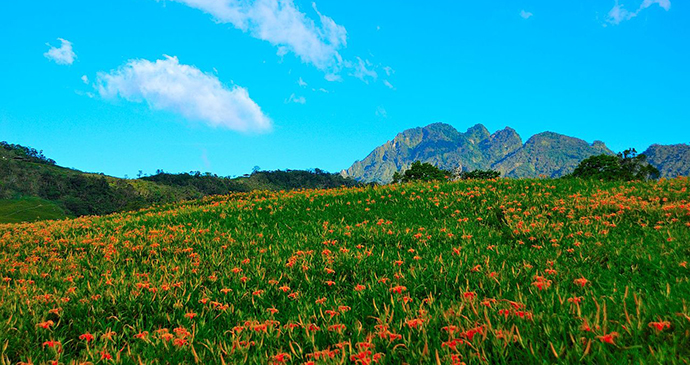 The East Rift Valley is known for its vast swathes of lush and unspoiled countryside © 徐月春, Wikimedia Commons
The East Rift Valley is known for its vast swathes of lush and unspoiled countryside © 徐月春, Wikimedia Commons
Guangfu 光復 (Guāngfù) is a good base for exploring the valley. Two-thirds of the township’s 14,000 inhabitants are aboriginal. The substantial Hakka minority came here to work in the sugar industry, which until a few years ago dominated the local economy. The sugar refinery still stands, but most of the cane plantations are now being afforested. The hot springs at Ruisui, developed during the Japanese era, still attract substantial numbers of Taiwanese tourists. However, for Western visitors the main draws are the valley’s natural appearance and opportunities to go hiking and white-water rafting.
Foguangshan
A stop on many package tours of Taiwan and for good reason, Foguangshan is one of Taiwan’s leading monasteries. Combined with the affiliated and adjacent Buddha Memorial Centre, it’s an excellent place to learn about Buddhism. Its founder, Master Hsing Yun (b1927), was already well known in religious circles when he purchased this plot of land in 1967.
Soon after arriving in Taiwan from the Chinese mainland in 1949, he became the first Buddhist monk in Taiwan to use radio programmes to spread his message. The propagation of Buddhism remains one of Foguangshan’s main goals and the monastery now operates a television station, worldwide network of Buddhist colleges and several publishing houses, while its charitable efforts include both a children’s and a senior citizens’ home.
Unlike I-Kuan Tao, Buddhism wasn’t suppressed by the government during the 1960s and its followers weren’t harassed. However, Buddhists were looked down on by Chiang’s pro-Western pro-Christian elite, and because of this many kept their beliefs to themselves.
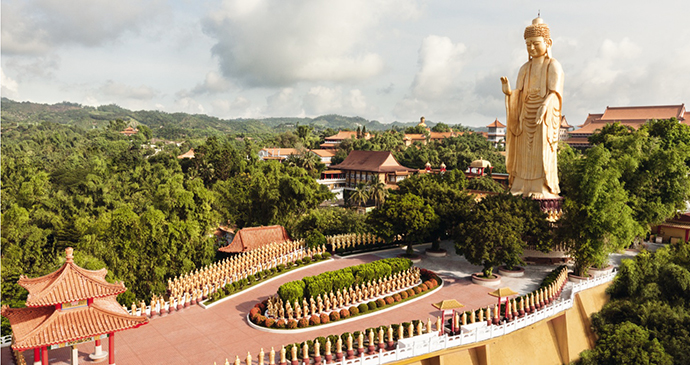
Hsing Yun chose the name Foguangshan, which means ‘The Light of Budda Mountain’, because he wanted Buddhists to be explicit about their religious affiliation. Foguangshan’s overseas arm is known in English as the Buddha’s Light International Association.
Monks and nuns who speak English and other foreign languages are available to guide individuals or small groups if given a few days’ notice, although if you roll up unannounced you’ll still be welcomed and at the very least given an English-language map. The architecture isn’t remarkable, but still it’s easy to spend half a day here.
Three parts of the monastery are essential viewing. The Main Shrine (07.00–19.00 daily), externally grandiose, is stunning within. The three main Buddhas, each five times the height of a man, project a calming benevolence; 14,800 smaller Buddhas are ensconced in the walls. The other two must-sees appeal in very different ways.
The Cultural Exhibition Hall (09.00–17.00 Tue–Sun; free admission) is a large gallery that hosts new displays every two or three months. Some of the featured artists are world class, and while the works displayed are seldom overtly Buddhist, they are in keeping with Buddhist ideals.
Pure Land Cave (09.00–17.00 Tue–Sun; admission by donation) depicts the paradise described in Buddhist sutras, complete with flashing lights and animatronic figures. The most memorable tableau features zombie-like humans stumbling into the arms of a giant Buddha.
Among the crowd there are Asians, Europeans and Arabs, but no-one of African descent. Pure Land Cave was opened in 1972, which perhaps explains why the Westerners are dressed like 1950s suburbanites.
At meal times, monks and nuns gather with lay people attending retreats. Before and after eating, sutras are chanted, and food is consumed in absolute silence. Casual visitors are permitted to watch and listen through the doorway. For a more conventional dining experience, head to the vegetarian tea house (10.00–19.30 daily) in the basement of the Dharma Transmission Centre. The menu lists tasty rice and noodle dishes, hot pots, teas, coffees and fresh juices.
Green Island
No-one can dispute the aptness of the name. Created by an undersea volcanic eruption, Green Island, is dominated by rich verdure and dark mossy hues that go well with the black cliffs and grey pyroclastic boulders. And it’s all alone, 33km from Taiwan’s shores. There’s no archipelago here, just a few rocks above water at high tide to keep the island company. It’s been Green Island only since 1949 – previously it was known as ‘Fire-Scorched Island’ because the inhabitants used to light fires on the hillsides to guide fishing vessels home. Since 1803 the islanders (current population 3,500) have been Han Chinese. Austronesian people certainly lived here a few centuries back and possibly as long as 4,000 years ago, but who exactly they were, and when and why they left, isn’t known for sure.
In 1951, Chiang Kai-shek’s regime decided to use the island as a place of imprisonment and exile for communist agents, subversives and political opponents. Thousands of prisoners were shipped here for interrogation and re-education; torture was routine and executions commonplace. Prisoners broke rocks on the beaches and helped build the airport. The last political convict was released in May 1990 (he’s now a respected member of parliament) and visitors can tour the buildings where prisoners were held. Ordinary criminals, among them some leading mafiosi, continued to be housed in an off-limits high-security institution that’s one of the island’s major employers.
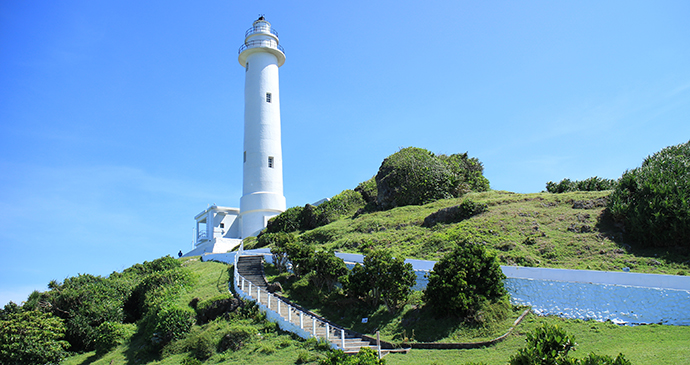
Lyudao lighthouse stands out as a beacon as you approach the coastline of Green Island © Windyboy, Shutterstock
At high tide the island’s land area is just 15km², while at low tide this expands to a little over 17km² as receding waters expose coral platforms rich in marine life. The fish, crabs and other creatures that inhabit the tidal zone make snorkelling a very popular pastime, second only to soaking in one of the world’s three saltwater hot springs. Local tour operators have made the snorkelling so safe even non-swimmers can join in and get a glimpse of what’s beneath the surface. Because the Kuroshio Current draws fish towards the island and then traps them just offshore, there’s some excellent scuba diving. Many divers prefer the winter months when underwater visibility is often 20m.
For general visitors, April and May are good months as temperatures and humidity levels are lower than during the summer peak season, and the strong winds that sometimes make winter ferry crossings extremely uncomfortable are seldom a problem. If the sky isn’t hazy, from the boat you’ll get capital views of the mountains that abut Taiwan’s east coast; you may see flying fish skim the waves and perhaps a dolphin or two. Approaching the rugged coastline in gloomy weather provokes a stirring, ends-of-the-earth sensation. For convicts and dissidents this must have exacerbated their despair. For many visitors, however, it’s central to Green Island’s appeal.
Kenting National Park
Taiwan’s first national park, established in 1984, has been more of a tourist-industry triumph than a conservation success, its record having been marred by squabbles over beach access. However, the park authorities have made some progress in recent years, closing down undesirable businesses (such as noisy go-kart circuits) and trying to balance environmentalist ideals with the rights of human residents, some of whom have lived in the area for generations and resent being told how they can or can’t use their land.
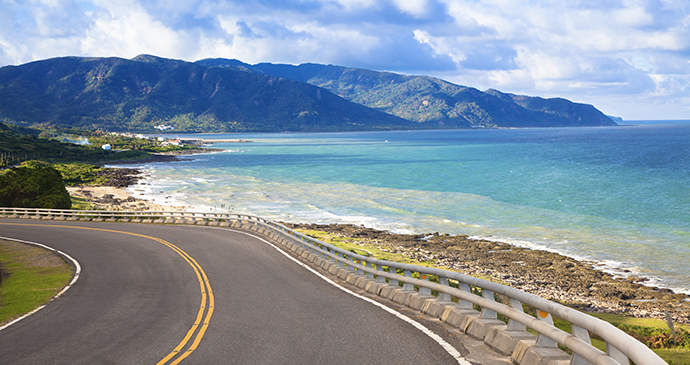
The coastal road through Kenting National Park is truly stunning, if a little crowded during peak tourist season © Tom Wang, Shutterstock
Millions of visitors pass through the park each year, occasionally jamming the coast road, and much of the area suffers from congestion and overdevelopment. Nevertheless, there’s plenty to do without dipping your toes in the ocean. If you can, escape to the hinterland to enjoy scenes of bucolic beauty, excellent birdwatching (the region has 31 of Taiwan’s 33 diurnal raptor species) and some truly pleasurable motoring. Alternatively, head out to sea and under the waves with one of Kenting’s English-speaking scuba instructors.
Little Liuqiu Island
Whether you arrive at Baisha 白沙 or the smaller settlement of Dafu 大福, your first thought is likely to be that Little Liuqiu isn’t very different from the rest of Taiwan. The town behind the ferry dock at Baisha is a dense collection of three-storey concrete boxes, and hundreds of tripod-shaped coastal fortifications have been piled up where the land meets the sea. Three temples are visible (Liuqiu has an amazing number of folk shrines considering its population, a mere 12,100), and the moment you step off the boat you’ll find yourself in a whirligig crowd of people and motorcycles.
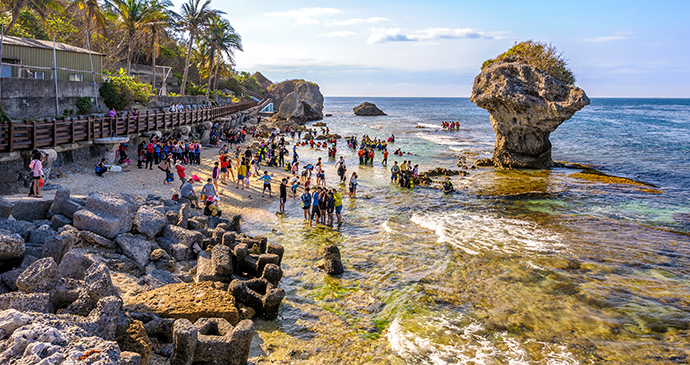
The island’s best-known and most-photographed coastal feature is a rock outcrop that’s shaped like a giant mushroom © Richie Chan, Shutterstock
Don’t let these initial impressions put you off. Fortunately, there’s no more to Baisha than what you see from the boat – and it’s the island’s biggest settlement. Little Liuqiu is a jewel surrounded by clean seas. The ‘little’ is to distinguish it from Japan’s Ryukyu Islands (now called Okinawa), the name of which was written using the same Chinese characters. The island is largely uplifted coral reef and thus unsuitable for farming, so you’ll see not a single rice field and very few vegetable gardens. Nonetheless, food and other necessities are no more expensive on the island than in Donggang or Kaohsiung, so there’s no need to haul lots of provisions with you.
The absence of industry and the tiny number of cars mean that the sounds of nature can be heard everywhere: waves, wind and birdsong. The vibe is unusually and genuinely relaxing. No wonder, then, that some expats head here rather than Kenting when they want a get-away-from-it-all weekend. Twenty kinds of coral and 300 fish species make Liuqiu a good place for snorkelling, and there’s also superb scuba diving but no infrastructure for divers who don’t speak Chinese.
English-language sources sometimes refer to the landmass as Lamay Island because its original inhabitants were the Lamayans, an Austronesian tribe. In 1621 and again in 1631, tribesmen massacred European shipwreck survivors. The VOC attacked the tribe in 1636. Most of those fighting on the Dutch side were recruits from other Taiwanese tribes that despised the Lamayans. The climax was a siege at what’s now called Black Ghost Cave, where more than 300 Lamayans were massacred and the survivors were sold into slavery. After that, Little Liuqiu had no permanent human population until the ancestors of the current islanders arrived from Fujian in the late 18th century.
Lukang
Touristy yet crammed to the gills with genuine culture and antiquity, Lukang (often spelled ‘Lugang’) is rightfully one of Taiwan’s most popular lowland destinations. It’s hard to believe now but, from the mid-18th century to the last quarter of the 19th century, this out-of-the-way town (population now 87,000) was Taiwan’s second-largest city. In that era, Tainan and Lukang were like Taipei and Kaohsiung now – the former focused on politics and government, the latter obsessed with commerce. While not quite frozen in time, Lukang has preserved enough of its physical past to make it worth an entire day. The town is easy to reach by bus and almost every sight is within walking distance of the core.
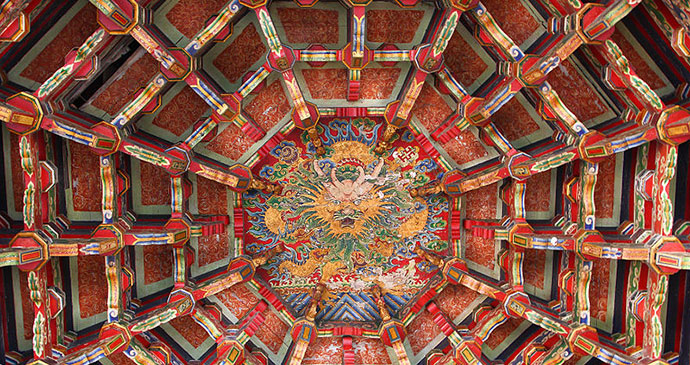
Longshan Temple is undoubtedly one of Taiwan’s most inspiring places of worship and likely the oldest Buddhist shrine on the island © AngoMoKio, Wikimedia Commons
Putou and Yaolin streets, along with several nearby lanes, have never been widened for cars. During Lukang’s heyday, many of the town’s shipping agents and merchants lived hereabouts, and several of the homes are now souvenir shops but what must have been one of the most imposing mansions is uninhabited and crumbling at 8 Houche Lane. Hoping their sons would be as academically successful as the man who built Ding Mansion, the first few generations living at 8 Yaolin Street would order the youngsters to take their books and brushes to the attic, then remove the ladder that provided the only access. One of Lukang’s most popular photo opportunities is Half-Sided Well 半邊井 (12 Yaolin St). In the 18th and 19th centuries, it wasn’t unusual for rich households to dig private wells; the family here wanted the convenience of a water source near their front door but were public-spirited enough to have it straddle the boundary of their land so neighbours could also draw water.
Mount Jade
This is the peak everyone wants to bag. Consequently permit applications often exceed the fixed daily quota by a ratio of 10:1. Visitor numbers are kept down to protect the mountain’s fragile ecology and also because there isn’t much space in Paiyun Lodge 排雲山莊. Apart from limited camping options, the lodge is the only accommodation between the trailhead and the peak. It’s much easier to get permits for midweek dates than for weekends, but applications must be submitted well in advance. The process can be completed online (start at www.npm.cpami.gov.tw/en) but it’s best to get a hiking outfit to do the ‘paperwork’ for you. Mount Jade and some other trails in the national park are closed to the public for a month each year, sometime between January and March. The precise dates vary from year to year and may be brought forward or extended because of weather conditions.
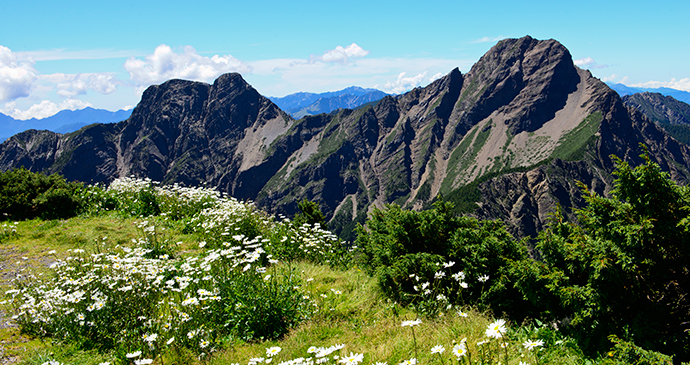
Scaling towering Mount Jade, Taiwan’s highest peak, is a welcome challenge for budding mountaineers © Chun-tso Lin, Dreamstime
Most hikers spend two days and one night on Mount Jade and scale the main peak only. Before beginning the walk to Paiyun Lodge it’s necessary to go to the police checkpoint (06.00–18.00 daily) to have your permits inspected. You’re advised to fill your water bottles there, especially if you’re tramping the 2.8km to the actual trailhead at Tataka Anbu. Private vehicles are not allowed past the checkpoint; the only alternative to walking is to jump on one of the minibuses that shuttle between the highway, the checkpoint and the saddle (NTD100 pp one-way). From Tataka Anbu (2,600m) it’s 8.5km to Paiyun Lodge. The track to Mount Jade is to the left. The surfaced road dropping down to the south is only open to scientific researchers. Soon after stepping on to the trail, you may see Taiwan laughing thrushes (Garrulax morrisonianus) scampering ahead of you; they’ve become totally unafraid of humans.
Penghu Islands
Located on the Tropic of Cancer some 45km west of Taiwan, all but one of Penghu County’s 90 islands emerged from the sea as a result of volcanic activity. When the basaltic lava pouring from the ocean bed between eight and 17 million years ago cooled, it formed the hexagonal columns that give the archipelago’s cliffs and tablelands a special appearance.
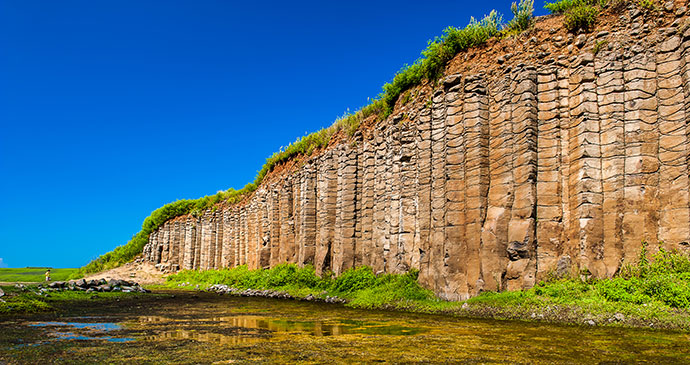
These basalt columns are relics of the Penghu Islands’ emergence from the sea due to volcanic activity © HTU, Shutterstock
Han people began settling the islands nearly 1,000 years ago, but Penghu didn’t become part of the Chinese empire until a Yuan Dynasty official was sent to administer them in 1281. The population grew very slowly because life was harsh; farming was difficult and pirate raids were so frequent that in 1372 the imperial authorities commanded the inhabitants to return to the Chinese mainland. Not everyone left, it seems – in 1404 visiting officials ordered another evacuation, but again many stayed on. Dutch vessels visited in 1604 and in 1622 the VOC began building a fort. Two years later, however, the Chinese emperor ordered them to leave – and sent so many ships and soldiers the Dutch had no choice but to go. Because they couldn’t set up a permanent base on Penghu, they landed at what’s now Tainan. The Dutch weren’t the first Westerners to set eyes on Penghu – during the 16th century, Portuguese sailors heading for Japan came here and named the islands Pescadores, meaning ‘fishermen’.
Seafood has always been a staple because the climate is too dry and the soil too sandy for many crops; you’ll see no rice fields. Also, farmers have to surround their vegetable patches with high walls to keep out the strong, salt-bearing winds. Along with beaches and ancient, abandoned houses, these windbreaks – usually piled-up chunks of basalt – are one of Penghu’s distinctive and recurring sights. During the Japanese colonial era, one of the archipelago’s few non-fish exports was lime, produced by firing a mixture of sand, coral and sea shells. More recently, the central and local governments have been saying that casinos would give the islands’ economy a big boost, but when a referendum was held in 2009, county residents rejected the proposal. Many folk worried that gambling would bring crime and other social problems, and it’s been argued that the islands simply don’t have enough fresh water to cope with a surge in visitor numbers.
Over time, Penghu’s population (currently 99,000) has been shifting away from the remoter villages and islands and towards Magong, the county’s administrative centre and a city rich in historical flavour. If you arrive by plane, you’ll notice the county is pretty flat; the highest point on the main island (also called Penghu) is 48m above sea level. The islands used to be almost treeless, but in recent decades government-sponsored afforestation efforts have changed this. Among the archipelago’s ecological attractions are turtles and avians; the endangered green turtles (Chelonia mydas japonica) that lay their eggs on Wangan Island between May and October are protected by ROC law. Cat Island, despite its name, is a haven for seabirds.
June is a good time to come, as is September, but the peak months of July and August are best avoided because of the crowds and the heat. Generally speaking, winter in the archipelago isn’t much fun as chilly winds blast the landscape.
Sanyi
Taiwan’s foremost woodcarving centre and its surroundings make for an excellent day trip from Taichung or Hsinchu but if possible, stay overnight so you can give the area the time it deserves.
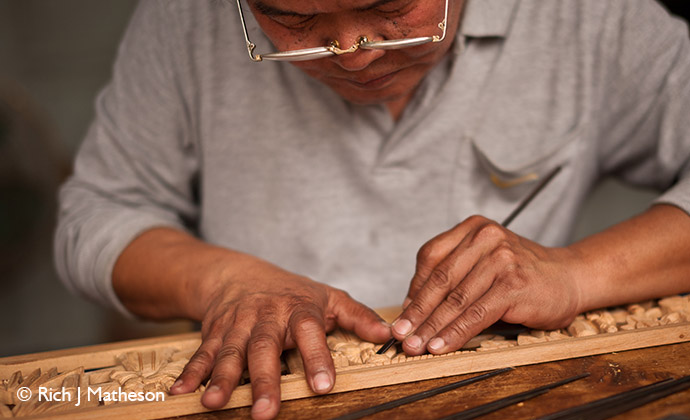 Come to Sanyi to see master skillsmen at work creating intricate carvings © Rich Matheson
Come to Sanyi to see master skillsmen at work creating intricate carvings © Rich Matheson
The woodcarving industry began here during the early part of the Japanese colonial period when the local camphor forests were heavily logged. Roots and stumps were plentiful and carvings made by local artisans were popular with Taiwanese and Japanese Buddhists. Americans were important customers after World War II: Catholics commissioned sculptures of the Virgin Mary while soldiers based in Taiwan picked up souvenirs. Each summer there are exhibitions and competitions.
In addition, gorgeous valleys and forest-covered hills lie to the east of Sanyi, but to explore them you’ll need your own car or motorcycle or to be a determined cyclist.
Shei-Pa National Park
With 51 mountain peaks above 3,000m, Shei-Pa National Park features some of Taiwan’s very best alpine scenery. Because this 76,850ha park is entirely in the subtropics and the lowest spot is 760m above sea level, temperatures often go very low. Typically, the mornings are gloriously clear but the weather in the afternoons is often cloudy or wet, while blizzards are a possibility in wintertime.
The park gets its English name from peculiar renderings of its two most notable peaks: Snow Mountain (variously known as Syueshan, Hsuehshan and Mount Xue) and Mount Dabajian (sometimes Dabajian Mountain). The former is Taiwan’s second-highest mountain; at 3,886m (12,749ft) it’s just 66m shorter than Mount Jade. The latter, which reaches 3,490m, has – from some directions at least – a distinctive cylindrical appearance.
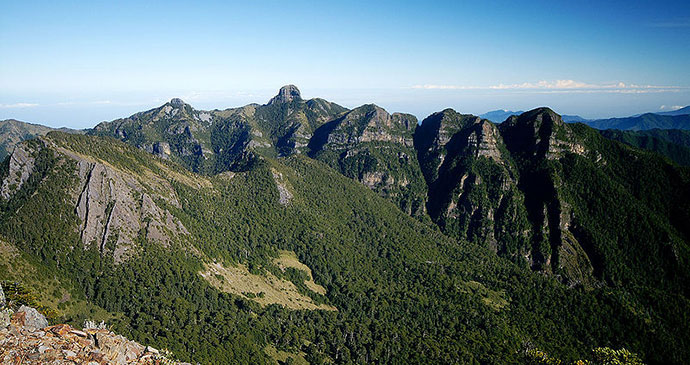
Mount Dabajian forms part of Shei-Pa National Park’s beautiful alpine scenery © Peellden, Wikimedia Commons
It’s also considered a holy spot by Atayal and Saisiyat aborigines. The first recorded ascent was by a team of Japanese climbers in 1927; one of them, Numai Tetsutaro, later described the crest-line between Mount Dabajian and Snow Mountain as a ‘holy ridge’. This name has stuck and serious hikers may want to consider spending up to ten days doing what’s now called the Holy Ridge ‘O’ Route. Another popular trek is Snow Mountain West Ridge Trail, which takes six days.
Tainan
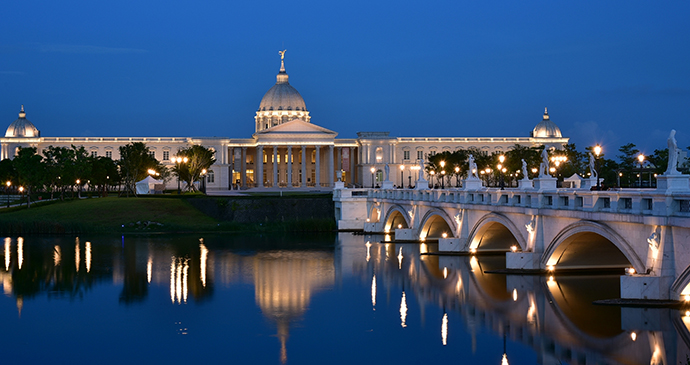
The Chimei Museum in Tainan houses a startling mix of stuffed animals and birds, weapons, armour, oil paintings and sculptures © Liu Chun Yen, Shutterstock
Visiting Tainan is essential if you hope to learn about Taiwanese history, religion or traditional life. Comparisons to Kyoto are often made and aren’t far off the mark. Taiwan’s former capital has more government-recognised first-grade relics than any other city; on every street there are signs of the pre-industrial past. However, Tainan is easier to navigate than Japan’s cultural treasure house – most of the sights can be walked to – and a good deal less expensive. It’s a place where temples don’t charge admission and where sightseers often find themselves far outnumbered by those visiting for reasons of piety. Among Taiwanese, Tainan is almost as famous for its snack foods as it is for traditional culture. Westerners find many of these delicacies rather odd but the brave and the gluttonous will have a field day. About three-quarters of a million people live in Tainan’s urban core.
Taipei
Twenty-first-century Taipei is a delightful metropolis in which to spend time. It’s safe and easy to get around and there’s plenty to see and do in multiple categories including museums, temples, gastronomy, nature rambles and shopping.
Taiwan’s capital, often compared with Hong Kong or Singapore and found lacking, is the nearest Greater China has to a renaissance city. The money-making here is avid, to be sure, but feels less visceral than in Hong Kong. Compared with Singapore, far less English is spoken but more genuine friendliness is expressed. There’s greater freedom and civility here than in any other Han-majority metropolis. With 2.67 million people, Taipei will never rival London, Paris or Tokyo in artistic output or economic significance, but, it certainly holds its own when compared with Asian cities twice the size – and thanks to the mountains that limit Taipei’s sprawl, getting lungfuls of fresh air and eyefuls of green forest isn’t difficult.
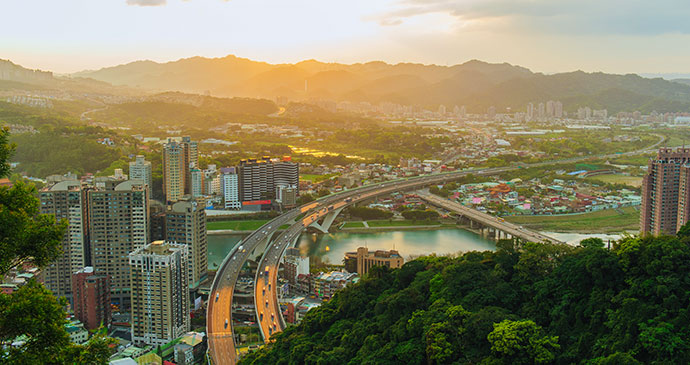
The delightful metropolis of Taipei is a hive of cultural activity © Richie Chan, Shutterstock
Relatively few of Taipei’s buildings are older than the Chiang Kai-shek Memorial Hall (completed in 1980) yet the city is streaked with veins of antiquity. The richest of these are in Wanhua, a down-at-heel, Taiwan-as-Formosa-used-to-be neighbourhood, and the riverside district called Dadaocheng.
For many, the mere fact that Taipei has the world-class National Palace Museum justifies time in the capital. Visitors shouldn’t, however, obsess about that stupendous repository to the exclusion of other attractions, such as the exquisite Baoan Temple. Nor should they pack their schedule with too much sightseeing, as one of Taipei’s most pleasurable pastimes is simply lingering on a busy street and watching passers-by: office workers in the latest fashions, Buddhist nuns, Tibetan monks, southeast Asian labourers and swarms of college and high-school students.
Taroko Gorge
Deservedly one of Taiwan’s leading tourist destinations, Taroko Gorge is a true, not-to-be-missed geological spectacular. Of the many eye-popping sights, the most dramatic is the stretch where the gorge narrows from a classic V-shaped valley to a defile that turns the sky into little more than a sliver of blue, hundreds of metres above visitors’ heads.
Tourists have been visiting the gorge since the 1930s, but only in meaningful numbers since the completion of the Central Cross-Island Highway in 1960. Most people spend their time gazing up at the clifftops or along the meandering Liwu River Valley. Yet the boulders that rest on the riverbed are also capable of making a strong impression, and not only because of their gargantuan dimensions. The Taroko area is synonymous with marble (quarrying used to be one of this region’s most important industries) but because of mineral impurities and an abundance of schists and gneiss, you’ll see rocks of pure white, dark grey, cream, silver, light brown and even soft shades of gold.
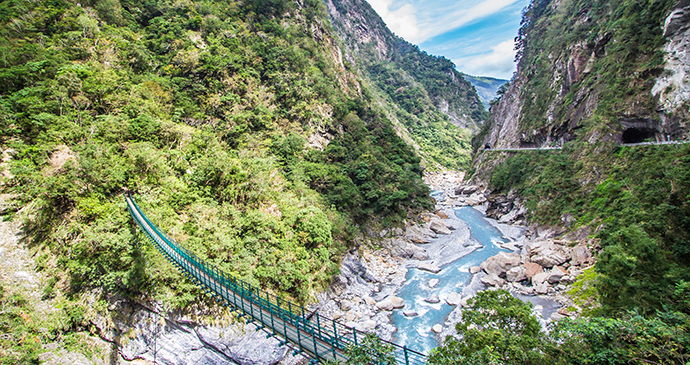
At its most dramatic point, Taroko Gorge narrows to a defile that turns the sky into little more than a sliver of blue © ThePonAek, Shutterstock
Visitor and tour-coach numbers peak in the middle of the afternoon so it’s best to make as early a start as possible. The good news is that there’s no bad time of year to come here. During summer the Liwu and its tributaries are full of vigour, but landslides sometimes close hiking trails or even the main road. The autumn can be very lovely indeed, and even in winter there are many dry, sunny days when a good number of the national park’s 144 bird species and 251 kinds of butterfly are active and visible. Springtime sees an abundance of flowers, including purple azaleas.
Hard-core mountaineers should consider Taroko National Park’s other attractions, such as Mount Nanhu (3,742m), Taiwan’s fifth-highest peak, or the notoriously dangerous Mount Qilai (3,605m). Permits must be obtained before you can climb either of these mountains.
Related books
For more information, see our guide to Taiwan:
Related articles
Nothing found.
